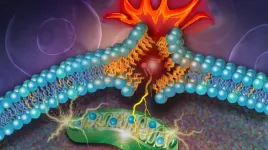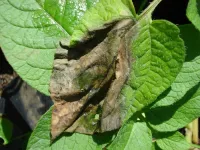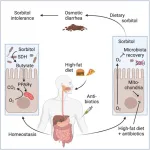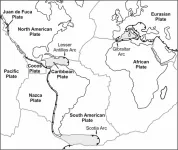(Press-News.org) Researchers report February 15 in the journal Cell that ancient viruses may be to thank for myelin—and, by extension, our large, complex brains. The team found that a retrovirus-derived genetic element or “retrotransposon” is essential for myelin production in mammals, amphibians, and fish. The gene sequence, which they dubbed “RetroMyelin,” is likely a result of ancient viral infection, and comparisons of RetroMyelin in mammals, amphibians, and fish suggest that retroviral infection and genome-invasion events occurred separately in each of these groups.
“Retroviruses were required for vertebrate evolution to take off,” says senior author and neuroscientist Robin Franklin of Altos Labs-Cambridge Institute of Science. “If we didn’t have retroviruses sticking their sequences into the vertebrate genome, then myelination wouldn’t have happened, and without myelination, the whole diversity of vertebrates as we know it would never have happened.”
Myelin is a complex, fatty tissue that ensheathes vertebrate nerve axons. It enables rapid impulse conduction without needing to increase axonal diameter, which means nerves can be packed closer together. It also provides metabolic support to nerves, which means nerves can be longer. Myelin first appeared in the tree of life around the same time as jaws, and its importance in vertebrate evolution has long been recognized, but until now, it was unclear what molecular mechanisms triggered its appearance.
The researchers noticed RetroMyelin’s role in myelin production when they were examining the gene networks utilized by oligodendrocytes, the cells that produce myelin in the central nervous system. Specifically, the team was investigating the role of noncoding regions including retrotransposons in these gene networks—something that hasn’t previously been explored in the context of myelin biology.
“Retrotransposons compose about 40% of our genomes, but nothing is known about how they might have helped animals acquire specific characteristics during evolution,” says first author Tanay Ghosh, a computational biologist at Altos Labs-Cambridge Institute of Science. “Our motivation was to know how these molecules are helping evolutionary processes, specifically in the context of myelination.”
In rodents, the researchers found that the RNA transcript of RetroMyelin regulates the expression of myelin basic protein, one of the key components of myelin. When they experimentally inhibited RetroMyelin in oligodendrocytes and oligodendrocyte progenitor cells (the stem cells from which oligodendrocytes are derived), the cells could no longer produce myelin basic protein.
To examine whether RetroMyelin is present in other vertebrate species, the team searched for similar sequences within the genomes of jawed vertebrates, jawless vertebrates, and several invertebrate species. They identified analogous sequences in all other classes of jawed vertebrates (birds, fish, reptiles, and amphibians) but did not find a similar sequence in jawless vertebrates or invertebrates.
“There’s been an evolutionary drive to make impulse conduction of our axons quicker because having quicker impulse conduction means you can catch things or flee from things more rapidly,” says Franklin.
Next, the researchers wanted to know whether RetroMyelin was incorporated once into the ancestor of all jawed vertebrates or whether there were separate retroviral invasions in the different branches. To answer these questions, they constructed a phylogenetic tree from 22 jawed vertebrate species and compared their RetroMyelin sequences. The analysis revealed that RetroMyelin sequences were more similar within than between species, which suggests that RetroMyelin was acquired multiple times through the process of convergent evolution.
The team also showed that RetroMyelin plays a functional role in myelination in fish and amphibians. When they experimentally disrupted the RetroMyelin gene sequence in the fertilized eggs of zebrafish and frogs, they found that the developing fish and tadpoles produced significantly less myelin than usual.
The study highlights the importance of non-coding regions of the genome for physiology and evolution, the researchers say. “Our findings open up a new avenue of research to explore how retroviruses are more generally involved in directing evolution,” says Ghosh.
###
This research was supported by the Adelson Medical Research Foundation, the UK Multiple Sclerosis Society, the Wellcome Trust, and the Altos Labs-Cambridge Institute of Science.
Cell, Ghosh et al., “A retroviral link to vertebrate myelination through retrotransposon RNA mediated control of myelin gene expression” https://cell.com/cell/fulltext/S0092-8674(24)00013-8
Cell (@CellCellPress), the flagship journal of Cell Press, is a bimonthly journal that publishes findings of unusual significance in any area of experimental biology, including but not limited to cell biology; molecular biology; neuroscience; immunology; virology and microbiology; cancer; human genetics; systems biology; signaling; and disease mechanisms and therapeutics. Visit http://www.cell.com/cell. To receive Cell Press media alerts, contact press@cell.com.
END
Columbia researchers have found that a rare type of lipid is a key driver of ferroptosis, a form of cell death discovered by Columbia professor Brent Stockwell.
The findings provide new detail on how cells die during ferroptosis and could improve understanding of how to stop ferroptosis in contexts where it is harmfully occurring– in neurodegenerative diseases, for example– or induce it in contexts where it could be useful, such as using it to kill dangerous cancer cells.
The new research found that a rare type of ...
The first accurate maps of outbreaks of potato blight — a disease caused by the fungus-like pathogen Phytophthora infestans that was responsible for the Irish potato famine between 1845 and 1852 — in the USA between 1843 and 1845 are presented in a study published in Scientific Reports. The findings improve our understanding of the spread of potato blight before the disease reached Europe.
Jean Ristaino and colleagues mapped outbreaks of potato blight in North America between 1843 and 1845 by analysing historic agricultural reports published in the USA during this period. The authors found that the disease was first reported ...
An innovative treatment significantly increases the survival of people with malignant mesothelioma, a rare but rapidly fatal type of cancer with few effective treatment options, according to results from a clinical trial led by Queen Mary University of London.
The phase 3 clinical trial, led by Professor Peter Szlosarek at Queen Mary and sponsored by Polaris Pharmaceuticals, has unveiled a breakthrough in the treatment of malignant pleural mesothelioma (MPM), a rare and often rapidly fatal form ...
About The Study: In this study of primary-care patients with obesity, all weight management treatments (nutrition counseling, very low-calorie meal replacement, anti-obesity medications, and bariatric surgery) increased the patient-level probability of achieving 5% or greater weight loss, but current rates of utilization are low and insufficient to reduce weight at the population level.
Authors: Dina H. Griauzde, M.D., M.Sc., of the University of Michigan in Ann Arbor, is the corresponding author.
To access the embargoed study: Visit our For The Media website at this link https://media.jamanetwork.com/
(doi:10.1001/jamanetworkopen.2023.56183)
Editor’s ...
About The Study: Moderate or severe and penetrating traumatic brain injury (TBI) were associated with the subsequent development of brain cancer in this study of more than 1.9 million veterans of the Iraq and Afghanistan wars. However, mild TBI was not associated with later brain cancer diagnoses.
Authors: Ian J. Stewart, M.D., of the Uniformed Services University of Health Sciences in Bethesda, Maryland, is the corresponding author.
To access the embargoed study: Visit our For The Media website at this link https://media.jamanetwork.com/
(doi:10.1001/jamanetworkopen.2023.54588)
Editor’s ...
North Carolina State University researchers used text analytics on both historic and modern writing to reveal more information about the effects and spread of the plant pathogen – now known as Phytophthora infestans – that caused the 1840s Irish potato famine and that continues to vex breeders of potatoes and tomatoes.
The study examined keyword terms like “potato rot” and “potato disease” after digitizing historic farm reports, news accounts and U.S. Patent Office agricultural records from 1843 ...
Large national study finds that video visits, texting and mailing pills are all effective, as the U.S. Supreme Court considers limiting access to telemedicine abortion.
Medication abortion can be delivered safely and effectively through telemedicine, according to new research from UC San Francisco that comes as the U.S. Supreme Court is about to hear a case that could severely restrict access to one of the two pills that are used to induce abortions.
Researchers analyzed data from more than 6,000 patients who obtained abortion ...
(SACRAMENTO, Calif.) — Researchers at UC Davis have identified changes in the gut microbiome that can result in an inability to digest sorbitol.
Sorbitol, a sugar alcohol, is used in sugar-free gum, mints, candy and other products. It is also found naturally in apricots, apples, pears, avocadoes and other foods. At high levels, sorbitol can cause bloating, cramps and diarrhea. For some people, even a small amount causes digestive upset, a condition known as sorbitol intolerance.
A new study with mice found that taking antibiotics, combined with a high-fat diet, reduced the number of Clostridia gut microbes, which can break down sorbitol. ...
With age, cells can experience senescence, a state where they stop growing but continue releasing inflammatory and tissue-degrading molecules. When a person is young, the immune system responds and eliminates senescent cells, often referred to as zombie cells. However, zombie cells linger and contribute to various age-related health problems and diseases. Mayo Clinic researchers, in two studies, shed light on the biology of aging cells.
In a study published in Aging Cell, Mayo Clinic researchers analyzed zombie ...
Contributed by Arianna Soldati, GSA Science Communication Fellow
Our planet’s lithosphere is broken into several tectonic plates. Their configuration is ever-shifting, as supercontinents are assembled and broken up, and oceans form, grow, and then start to close in what is known as the Wilson cycle.
In the Wilson cycle, when a supercontinent like Pangea is broken up, an interior ocean is formed. In the case of Pangea, the interior ocean is the Atlantic. This ocean has a rift in the middle, and passive margins on the side, which means no seismic or volcanic activity occurs along its shores. Destined to keep expanding, an Atlantic-type ...




